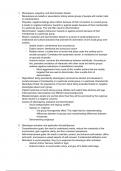1. Stereotypes, prejudice, and discrimination Kassin:
- Stereotypes are beliefs or associations linking whole groups of people with certain traits
or characteristics.
- Prejudice: negative feelings about others because of their connection to a social group.
It results in negative behaviour towards or against people because of their membership
in a particular group. This will often result in discrimination.
- Discrimination: negative behaviour towards or against persons because of their
membership to a particular group.
- Racism: prejudice and discrimination based on a person’s racial background or
institutional and cultural practices that promote the domination of one racial group over
another.
- Implicit racism: unintentional and unconscious
- Explicit racism: intentional and conscious racism
- Modern racism: a subtle form of racism that stays under the surface and is
socially accepted. Correlates with systematic racism, in institutions for example
on grounds of gender.
- Aversive racism: concerns the ambivalence between individuals. According to
this, persistent avoidance of interaction with other racial and ethnic groups
realises negative evaluations of racial/ethnic minorities.
- Micro-aggressions form a part of this: smaller actions that are racially
targeted that are used to discriminate. Also a subtle form of
discrimination.
- Stigmatized: being persistently stereotyped, perceived as deviant and devalued in
society because of membership in a particular social group or a particular characteristic.
- Stereotype threat: the experience of concern about being evaluated based on negative
stereotypes about one's group.
- Implicit racial bias is found among young children and explicit bias declines with age.
- Interracial bias: bias between two different racial backgrounds
- Metastereotypes: people are worried about how they will be perceived by the outgroup
which results in a negative outcome.
- Causes of stereotyping, prejudice and discrimination:
- Social categorization and ingroup conflict
- Ingroup vs. outgroup
- Out-group homogeneity effect: This might lead to underestimating
differences between in-groups and overestimating differences between
out-groups.
- Dehumanising outgroups
2. Stereotype activation and application Kunda/Spencer:
- Comprehension goals: the need to understand events, reduce the complexity of the
environment, gain cognitive clarity, and form coherent impressions.
- Self-enhancement goals: the need to maintain, protect, and enhance self-esteem, affirm
self-worth, and preserve valued aspects of self-concept. Fundamental attribution error.
- Motivation to avoid prejudice: they try to suppress the stereotype after activation.
- Internal motive: fairness, beliefs or logic.
- External motive: to avoid public outcry, and give off a better self-image.
,- Stereotype activation: people’s motivations will determine what happens with the
stereotype activation. Whether they want to use comprehension goals,
self-enhancement goals or avoid prejudice.
- Stereotype application: the extent to which one uses a stereotype to judge a member of
the stereotyped group.
- Attention to target category: the target is being linked to the group in which the
stereotype is created.
- Factors that influence activation:
- The level of prejudice you have already affects the activation process
- Time also affects the activation
- Sensitive topics
- Disagreement with someone from another group
- Factors that influence application:
- Strong social norms against prejudice and stereotyping can inhibit the behaviour.
- Self-affirming experience and enhancement of self-enhancement goals can be
decreased.
- Need for structure, for example, some people want control.
- A way to avoid it is to have excuses for the stereotype.
3. Does contact reduce prejudice or does prejudice reduce contact? Binder et al.
- Allport contact hypothesis: contact between groups is effective in reducing prejudice in
an equal setting and has to allow the development of close relationships.
- Conditions for contact hypothesis: equal status, personal interactions, cooperative
activities and social norms
- Contact effect: when people have contact, it reduces prejudice
- Prejudice effect: prejudice leads to less contact with outgroup
- The majority members showed stronger contact effects compared to members of ethnic
minorities, for whom such effects were non-existent. Minority members did not
experience significant contact effects unless outgroup friends were seen as highly typical
of their group.
, - Typicality: the finding that people are quicker to make category judgments about
typical members of a category than they are to make such judgments about
atypical members.
4. Acculturation, identity, and adaptation Berry et al.:
- Ethnic identity: family, upbringing and experiences that influence yourself. Ethnic identity
is the influence of cultures on your identity. Something that is constructed over time and
so it is not stable, but a dynamic product.
- The process of acculturation involves two key aspects: individuals' connection to their
original cultures and their connection to the new societies they settle in.
- The four acculturation strategies/processes:
- Assimilation: not wanting to retain your own culture, but actively searching for the
mainstream culture.
- Separation: retaining your own culture and avoiding the other culture, by for
example not talking to people of the other culture on purpose because you wish
to be separated.
- Integration: maintaining your ethnic culture, but also integrating the national
culture, however, you may need to let go of some of your ethnic values. The
degree of integration is important.
- Marginalization: excluding certain groups from cultural interactions, often due to
discrimination. It results in the loss of cultural identity and connection, causing
isolation and exclusion from society.
- Psychological adaptation: personal well-being, good mental health.
- Sociocultural adaptation: individuals’ social competence in managing their daily life in an
intercultural setting.
- Ethnic Profile: Strong ethnic ties and identity, language proficiency, and separation
tendency from larger society. (Positive for psychological adaptation, poor for
sociocultural).
- National Profile: Focus on society of residence, high assimilation, and weak ethnic
identity. (Positive for sociocultural adaptation, poor for psychological)
- Integration Profile: Balanced involvement in both cultures, avoiding extremes. (Best
psychological and sociocultural adaptation)
- Diffuse Profile: Uncertain identity, conflicting attitudes on assimilation and separation.
(Worst)
5. Mental health outcomes of ethnic identity and acculturation among British-born children
of immigrants from Turkey Cavdar et al.:
- A greater ethnic identity has a significant positive relationship with positive mental health.





